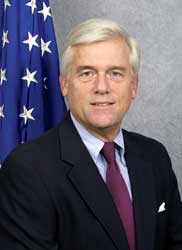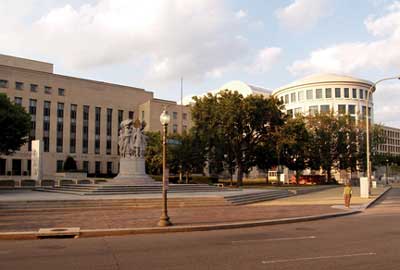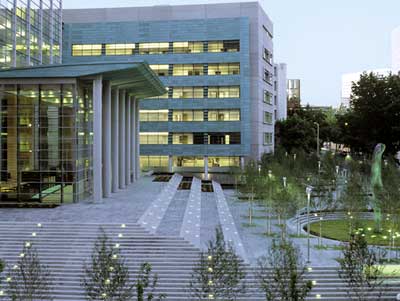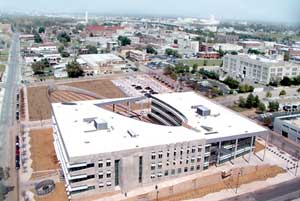lot of politicians and bureaucrats talk about their desire to make government “run more like a business.” Few actually do it.
One public official who’s having more success than most in bringing free- market
 |
| David Winstead |
principles and accountability to government is David Winstead. Last month, he marked his first year on the job as commissioner of the Public Buildings Service of the General Services Administration.
As the federal government’s chief real estate executive, Winstead is responsible for a property portfolio consisting of 8,920 assets with more than 342 million sq. ft. (31.8 million sq. m.) of rentable space in all 50 states, six U.S. territories and the District of Columbia. The PBS serves about one million federal employees at 59 different agencies with a portfolio that includes office buildings, courthouses, border stations and warehouses.
In 2005, the PBS saw funds from operations increase by $151 million and net revenue increase by $35 million. The $116- million difference represents improvements in operational efficiency, benefits from restructuring and lower vacancy rates. While the private sector nationwide recorded an average vacancy rate of 12.5 percent in 2005, PBS reduced the vacancy rate of its inventory to a record low of 4.1 percent.
Last year PBS sold off 50 federal buildings and took some 3 million sq. ft. (279,000 sq. m.) of vacant space off the backs of the American taxpayers. “We generated values of $383 million a year in cost avoidance,” says Winstead.
In a recent interview with Site Selection, Commissioner Winstead discussed the professional background that prepared him for this job and talked about the continued effort to make GSA’s real estate arm not just operate more like a business, but actually outperform the private sector in several key areas.
Site Selection: How did your background — particularly in the practice of real estate law at Holland & Knight — prepare you for this job?
 |
Commissioner Winstead: Even back in law school, I was working on real estate issues in Maryland, when I worked for a Maryland senior senator. We were involved back then with the major federal installations in Maryland. I later joined the largest zoning firm in Washington. It merged with Holland and Knight, which has more than 1,000 lawyers. A large part of its practice was real estate, both transactional and zoning and planning issues. I’ve been involved in site selection, representing municipalities like Rockville and Howard County on infrastructure issues. I have both private sector experience in real estate law and public sector experience. A little over a decade ago, I was involved in transportation issues in Maryland. [Winstead was head of the DOT of Maryland.] I was in charge of the Port of Baltimore, BWI Airport and the Motor Vehicles Administration. I picked up the reins here last October.
SS: You have considerable economic development experience in the private sector. Do you see GSA as playing an important economic development role in the communities in which you have buildings and other assets? If so, how?
Winstead: We have a huge impact on the communities we serve. We have 200 field offices and 342 million square feet of space in more than 1,600 communities in both urban and rural markets. The federal government through GSA and PBS has a substantial impact on economic development in and around our sites. We are showing ourselves to be increasingly innovative in how we manage our core assets. For example, we consider how our decisions impact the federal and local job sector.
SS: What do you hope to accomplish during your tenure at PBS?
Winstead: One thing is increased efficiency. We generated over $35 million in revenue for a building on which we had spent about $10 to $12 million. We have 98.8 percent of our leased assets now performing at an acceptable level. We are investing in Tier 1 and Tier 2 assets and disposing of Tier 3, or underperforming, assets. Our operating costs are really quite competitive. We are still about 10.5 percent below the BOMA benchmarks for the private sector in terms of our overall utility costs and our energy buying programs. The net result of this restructuring and the new asset management approach is that we really are seeing results. Under- utilized assets have been reduced from 42 percent to 26 percent. About 75 percent of our assets now have an ROI of over 6 percent. We have seen a reduction in the vacancy rate to 4.1 percent, down from 9.2 percent. It’s all beginning to pay off at a time when it is, quite frankly, the right time to do so. Half of our portfolio is in leased space. We pay about $4.5 billion a year in rent for leased space. Our capacity to handle that is increasing. We are in the second year of a national brokerage contract that was put in place about a year and a half ago. We now have four brokerage firms under contract to get the best lease deals that we can. We had a recent GAO [Government Accountability Office] review of that. We seem to be managing it well. The net result is that we are seeing savings for our customers at a time they want us to deliver the most efficient, cost- effective space that we can. Our tenants are realizing impacts.
 |
| The $123- million Prettyman Courthouse Annex was dedicated on October 30, 2006. The GSA’s client is the Federal Judiciary- U.S. District of Columbia. The annex will add 351,000 gross sq. ft. (32,608 sq. m.) to the existing 643,000- sq.- ft. (59,735- sq.- m.) courthouse.
Photo: GSA/Taylor Lednum |
SS: How involved are people at the local level in facility decisions?
Winstead: We have an urban development program here. There is a substantial part of the site guide that talks about community planning. We do our best to make sure that our decisions are compatible with local metropolitan planning. We have set policies for engaging local and regional groups. We have very substantial involvement with the city of Washington, D.C. In Lakewood, Colorado, we have a huge federal campus and are seeking to expand our land use there. We are incorporating metro Denver’s plans for light rail and mass transit into our complex. We worked with them (the local officials) on the mobility issue for both federal employees and private- sector office tenants. Our site guide has substantial sections on working through issues with community interests. Our major stakeholders are the members of Congress, who desire to keep federal offices and jobs in their districts. We have 11 regions across the country. I have to brief members of Congress on the location of a new federal courthouse. For example, I visited a more than 1 million- sq.- ft. [92,900- sq.- m.] IRS center in Kansas City. Our people worked with K.C. people to find the best site for the IRS center in downtown K.C. to tie into downtown redevelopment. We engaged early on with the political leadership of Kansas City. The site selection turned out to be very successful. We are moving in the next couple of months. We do this with both existing properties and in how we site new ones. We seek to make the best decision for our tenant and the best decision from the standpoint of the taxpayer.
SS: How would you assess the condition of GSA’s older facilities?
 |
| The yet-to-be-named 680,355-sq.-ft. (63,205-sq.-m.) U.S. Federal Courthouse in Seattle was completed in August 2004 at a cost of $172.7 million. Photo: Frank Ooms |
Winstead: My predecessor Joe Moravec launched a new asset management strategy, tiering them into 1, 2 and 3 categories. The goal is to generate revenues that can be used to renovate the buildings, and also to get assets to be performing. We also began looking at assets we need to dispose of and get off the books. We can then take the revenues we gain from those disposals and put them back into the renovation of our other facilities. The reality is that we have had this initiative over the last three or four years and we have had a lot of positive results. We have right- sized our portfolio. We have disposed of 29 vacant, under- used properties. About 80 percent of our properties are now performing by generating revenues at a level needed to sustain and improve the facilities. Every year, we have to send OMB [Office of Management and Budget] our proposal. We were actually able, through efficiencies gained, to reduce our brokerage rate from 8 to 7 percent for cancelable leases. We do allow our tenants to get out of leases. IRS pays about $28 million a year in fees to us, but this saves them about $2 to $3 million a year in fees.
SS: Which firms have national brokerage contracts with PBS?
Winstead: Four firms that have national contracts with annual extensions are Trammell Crow, Julian J. Studley, Jones Lang LaSalle and Staubach. We have been working with them and there is a constant review of their performance. We are managing it to be based on performance.
SS: How fast is your property portfolio growing?
Winstead: We have delivered 50 new courthouses over the last decade, which has increased rents to about $1 billion a year paid to PBS. The community was involved in the design and build process. We were able to get the best architects in the world to bid on these projects. Another six are in the design and development phase. We just opened the Brooklyn Courthouse in Brooklyn, designed by Cesar Pelli. Last December, we opened the brand new courthouse in Fresno [Calif.]. We also have a very active border station program. Under the Custom Border Protection program, we are out developing and doing site selection for the best location for these new buildings. With the border stations, they are very unique in the site selection and design processes. They are very, very complicated by the constrained nature of the site. We have about $690 million in our 2007 budget for new construction, and much of that is going into new border stations and courthouses.
 |
| Completed in May 2004, the 181,000-sq.-ft. (16,815-sq.-m.) Oklahoma City federal building cost $40 million. Tenants include the U.S. Food and Drug Administration, Department of Housing and Urban Development, General Services Administration, Small Business Administration, Department of Veterans Affairs and Department of Agriculture
Photo: GSA/ Timothy P. Thury |
SS: Has there been any new legislation affecting PBS?
Winstead: President Bush signed Executive Order 13327, which developed the 10 asset management guiding principles, in 2004. We reviewed the legislative initiatives, and we wanted to make sure we are being as aggressive as we can to make sure we have all the resources and creative financing we need. A bill currently going through Congress would encourage more agencies to create pilot projects to retain 20 percent of the disposal of real estate assets. This bill is being proposed by Congressman Tom Davis of Northern Virginia. We are assisting with that through the Federal Real Property Council. We are always looking to improve our utilization of tools. There could be other initiatives coming out in the coming year to broaden and improve our authority for doing innovative public- private initiatives. There was a lot of gain that resulted from Moravec’s efforts.
SS: What attracted you to this job?
Winstead: I had been involved with GSA over the years and I was aware of the federal building fund, particularly in the Washington, D.C., area. For example, I was involved in the new campus of the FDA [Food and Drug Administration] in Montgomery County, Maryland. I enjoyed my prior tenure in public service. I thought I could contribute my background in real estate law, development and transportation. I really had enjoyed my prior public service, and I am really enjoying it this time.
SS: What are your major challenges at GSA?
Winstead: Continuing to focus on customer service improvements. Restructuring our real estate team is still in refinement. Secondly, I’ve been putting a lot of attention into the construction and design excellence program by emphasizing improvements in the planning stages. With a capital improvement program of almost $700 million a year, I added another deputy commissioner in this area. We are seeing increased competition in the private sector, and that can drive up costs. Thirdly, we have added Workplace 2020, which adds better utilization of space for our clients. It will include a new book, Workplace Matters, which outlines our principles to help our clients in our own buildings and in our leased buildings. Lastly, we continue to be focused on how we are managing our resources and maintaining our buildings. We also have to allocate resources to meet the appetite of our clients.
SS: Do you have any advice for our readers?
Winstead: We are very committed to serve our clients and to work with the real estate advocates in our communities. It is very important for your readers to understand how we manage our assets and how they can help us with our portfolio by helping us deliver cost- efficient locations and facilities for our clients. Some 98 percent of the revenues that come into us through disposal of facilities and rents goes back out into the private sector in improving our facilities and building new ones. We conduct peer reviews on site selection, design and engineering. We have 500 people that serve on our design excellence review process. We reach out to the major planning organizations and real estate associations like ULI, NAIOP and BOMA. From my personal background, I have been involved in economic development and site selection throughout my career. I hope to share those experiences here. I hope we select the best sites for federal facilities by being engaged with those private groups. I know how important these decisions are, because our lease decisions have huge impacts on the growth of the areas around them.

